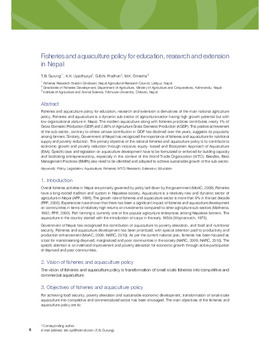Fisheries and aquaculture policy for education, research and extension in Nepal

Citation
Gurung, T.B. et al. (2012). Fisheries and aquaculture policy for education, research and extension in Nepal. p. 6-9. In: Shrestha, M.K. ; Pant, J. (eds.) Small-scale aquaculture for rural livelihoods: Proceeding of the National Symposium on Small-scale Aquaculture for Increasing Resilience of Rural Livelihoods in Nepal. Institute of Agriculture and Animal Science, Tribhuvan University, Rampur, Chitwan, Nepal and the WorldFish Center. Penang, Malayisa
Fisheries and aquaculture policy for education, research and extension is derivatives of the main national agriculture policy. Fisheries and aquaculture is a dynamic sub-sector of agriculture sector having high growth potential but with low organizational stature in Nepal. The modern aquaculture along with fisheries practices contributes nearly 1% of Gross Domestic Production (GDP) and 2.68% of Agriculture Gross Domestic Production (AGDP). This positive achievement of the sub-sector, contrary to others whose contribution in GDP has declined over the years, suggests its popularity among farmers. Similarly, Government of Nepal has recognized the importance of fisheries and aquaculture for nutritional supply and poverty reduction. The primary objective of the national fisheries and aquaculture policy is to contribute to economic growth and poverty reduction through inclusive, equity- based and Ecosystem Approach of Aquaculture (EAA). Specific laws and legislation on aquaculture development have to be formulated or enforced for building capacity and facilitating entrepreneurship, especially in the context of the World Trade Organization (WTO). Besides, Best Management Practices (BMPs) also need to be identified and adopted to achieve sustainable growth of the sub-sector. Fisheries and aquaculture policy for education, research and extension is derivatives of the main national agriculture policy. Fisheries and aquaculture is a dynamic sub-sector of agriculture sector having high growth potential but with low organizational stature in Nepal. The modern aquaculture along with fisheries practices contributes nearly 1% of Gross Domestic Production (GDP) and 2.68% of Agriculture Gross Domestic Production (AGDP). This positive achievement of the sub-sector, contrary to others whose contribution in GDP has declined over the years, suggests its popularity among farmers. Similarly, Government of Nepal has recognized the importance of fisheries and aquaculture for nutritional supply and poverty reduction. The primary objective of the national fisheries and aquaculture policy is to contribute to economic growth and poverty reduction through inclusive, equity- based and Ecosystem Approach of Aquaculture (EAA). Specific laws and legislation on aquaculture development have to be formulated or enforced for building capacity and facilitating entrepreneurship, especially in the context of the World Trade Organization (WTO). Besides, Best Management Practices (BMPs) also need to be identified and adopted to achieve sustainable growth of the sub-sector.
Permalink
Date Available
Type
Publisher
Copyright
CC BY 4.0
Research Themes
Language